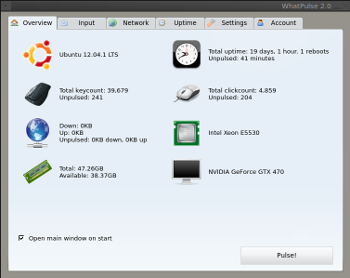 If, like me, you are a statistics freak you must install this small application on all your computers: WhatPulse
If, like me, you are a statistics freak you must install this small application on all your computers: WhatPulse
The software tracks a user’s pressed keys, mouse clicks and used bandwidth and the uptime of the system. Periodically, or by hand, the user can upload to the server the number of keystrokes made; this is called “pulsing”.
Users can see where they are in a leaderboard of people who have joined the program and compare themselves against people from their own countries. Users can also join teams, which enables them to compare themselves against people with similar interests (Go Linux Users !!).
There is a basic, and free, version where you can easily see and check all the basic statistics and a premium account where you can see some more stats.
The software is available for Linux, Windows and Mac.
Continue reading »

